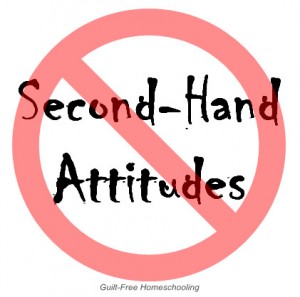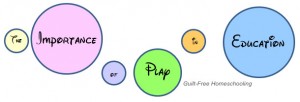 If you are a parent who thinks you could never homeschool, be encouraged: I used to be one of you. If someone had suggested back then that I should homeschool, I would have had a dozen reasons ready why I could not do it. One day, I ran out of reasons. Actually, the reasons why I wanted to try homeschooling began to outnumber my excuses for not trying it.
If you are a parent who thinks you could never homeschool, be encouraged: I used to be one of you. If someone had suggested back then that I should homeschool, I would have had a dozen reasons ready why I could not do it. One day, I ran out of reasons. Actually, the reasons why I wanted to try homeschooling began to outnumber my excuses for not trying it.
When my daughter was old enough for Kindergarten, I didn’t have to worry about homeschooling because it was not yet legal in my state. Later, I avoided homeschooling because I thought my toddler needed too much of my attention. Still later, it became obvious that the government’s public school system was failing both of my children, and I finally took a serious look at homeschooling. Our lives (and their education) changed completely within the next few months, and it has been a change that we have never regretted.
When people say they “could never homeschool,” they usually complete that thought with one of the lines listed below. Sometimes the line is spoken aloud, and other times it is merely implied. Still more often, the spoken phrase, “I could never homeschool,” stands alone as a substitute, a coded message, for one or more of these assertions. If you think you could never homeschool, give some consideration to these tongue-in-cheek explanations and reflect on why you feel homeschooling is not for you — be sure that you are not avoiding homeschooling for mere excuses.
I could never homeschool–
1. …I’m too disorganized. Homeschooling works with as much organization as you are willing to put forth. However, if you can keep your silverware sorted, you probably have what it takes.
2. …I don’t know how. Have you ever begun a new adventure already knowing everything about it? Like anything else in life, you learn as you go.
3. …I wouldn’t be any good at it. How do you know? Have you tried and failed at this before? If you have, then you know what problems to avoid this time.
4. …I’m too lazy. Are you saying that it is easier to get your children up, dressed, fed, and off to school at the crack of dawn five days a week, than it is to allow your children to do math in their pajamas?
5. …My husband/family won’t let me. Is that because you have run yourselves deeply into debt and need multiple incomes to keep up the payments? Or is it because of utopian ideas of what institutional schools can do for a child?
6. …I’m not smart enough. Did you teach your child to walk or talk? Did you help him learn to dress himself? Did you teach him to sing “Happy Birthday”? Then you probably have what it takes to teach him to print his name. The rest you can learn as you go.
7. …I don’t want my child to end up like that weird homeschooled kid I know. Don’t worry–your child will end up with his own brand of weirdness, whether he is homeschooled or not.
8. …I can’t stand to be around my children. This is a bigger problem that you need to resolve, no matter where your children go to school.
9. …My children can’t stand to be with me. Again, this is a bigger problem that you need to resolve, no matter where your children go to school.
10. …I want to support the local Christian school. That is an admirable goal, but is the Christian school more important than your own child? The quality of education (even at Christian schools) is far below what a child can receive at home. Also, Christian schools are populated with the thugs, bullies, and reprobates who managed to get themselves expelled from public school.
11. …I want to support the community through the public school. Again, is the community more important than your child’s welfare and education? The quality of education at public schools is far below what a child can receive at home.
12. …All my children’s friends go to public school. Any friends worth keeping can still be seen and played with after school or on weekends.
13. …I don’t have the patience to homeschool. Did you become impatient when your child was learning to walk or talk? Were you impatient when helping him learn to ride a bike? Homeschooling is no different–it is teaching new skills to the children you love.
14. …My child has “special needs.” Many parents homeschool their “special needs” children, feeling that no other teacher can understand or care for their child better than the parents can.
15. …I don’t know any other homeschoolers–I would need help. Homeschooling is growing so quickly that there are probably some homeschoolers in your area already. There are also resources on the internet for helping you connect with homeschooling families near you.
16. …I don’t want to insult my friends who are public school teachers. Right. Because their feelings are so much more important than your child’s feelings and education.
17. …I have to work. Some families have been able to adjust their work schedules and their homeschooling schedule to fit together. Other families have found financial benefits to homeschooling that eliminated the need for both parents to work.
18. …My children don’t want to homeschool. How do they know? Have they tried it before? My children loved having a fully stocked refrigerator available in their classroom.
19. …I have a degree, a career, and a corner office that I have worked hard for, and I’m not giving that up. Right. Because it’s all about you, isn’t it? But your child would like his own chance to obtain a degree, a career, and a corner office.
20. …I can’t teach algebra, geometry, calculus, or chemistry. 1.) If your child is just starting Kindergarten, you don’t have to worry about the advanced subjects just yet. 2.) The lessons are all explained in the textbooks.
21. …My children won’t listen to me, don’t respect me, or don’t think I am smart enough. Some of this will disappear the first time you answer a question as Teacher, and more will be conquered as you continue to homeschool. However, some of this may stem from bigger problems that will need to be resolved no matter where your children go to school.
22. …I have a life and social commitments, and I’m not giving those up. It’s still all about you, isn’t it? Many commitments outside the home can still be maintained–and some may be easier because of the lack of school-related commitments during after-school hours.
23. …I don’t want to wear a denim jumper, put my hair in a bun, kill my own chickens, or have 18 children. And you don’t have to. Homeschooling should fit your family’s lifestyle–no matter what your lifestyle is. Some athletes homeschool around hours and hours of daily training, and some families homeschool on the road in the cab of an 18-wheeler. Homeschooling adapts to you and your lifestyle.
24. …It costs too much money to homeschool. Many of the costs associated with homeschooling (such as curriculum purchases) can be spread out by re-using the materials for several students, or recouped by reselling the materials when you are finished with them.
25. …We can’t afford to start now; maybe we’ll start next year. Along with your financial costs, be sure to consider the personal costs to your child. In some cases, the emotional and mental anguish from one more year in public school can do irreparable harm.
26. …We might homeschool later when the kids really need it. How will you know if you’ve waited too long to start? In some cases, the emotional and mental anguish from one more year in public school can do irreparable harm.
27. …My child has been looking forward to going to public school, and I can’t break his heart. 1.) Your child is probably looking forward to either a ride on a school bus or a chance to play on the school playground. Are those more important than the quality of education? You can ride the city bus (or a church bus), visit a local playground, and then make cookies together at home (something he can’t do at school). 2.) Who is responsible for deciding what is best for the child–that child or you, the parent?
28. …I don’t want to go to jail–isn’t homeschooling against the law? No. Homeschooling is legal in all fifty states, as well as many foreign countries. Home School Legal Defense Association is consistently on top of homeschooling law cases and will support any member family at no cost. (info at http://hslda.org)
29. …I want my children to get into college. Homeschoolers are actively recruited by colleges for their dedication to excellence and self-motivated learning.
30. …Homeschooling isn’t really that important. Homeschooling can turn a poor student into a great student. Imagine what it can do for your student.
31. …I went to public school, and I turned out all right. The school you went to is no longer available. Schools are dramatically different now from what they were even five years ago. Ask a child who is currently in school what a typical day is like.
32. …I want my children to experience all the good things from public school. Again, the school you went to is no longer available, and you may have forgotten many of the painful or difficult times that accompanied your good experiences. Ask a child who is currently in school what a typical day is like.
33. …My baby/toddler takes up too much of my time. Have you found ways to prepare meals or do laundry with Baby around? Homeschooling can also be adapted around baby’s schedule, and toddlers and preschoolers love to join in the fun. There are many ways to homeschool with younger children about.
34. …My mother is a teacher! Then she should understand why you want to skip all of the undesirable elements of school and focus on personalized academics. It is a very rare grandmother who does not want the best for her grandchild. And you have the bonus that she can help teach your child how to stand in line for the bathroom or show you how to inspect him for head lice.
35. …My children won’t have any friends. Do they have friends now? They can still get together with the school friends they enjoy, and friends from the neighborhood or church will still be around. Homeschool support groups provide new friendship opportunities, plus field trips and group activities.
36. …I’m dyslexic–I can’t teach my child. Some dyslexia results from incomplete understanding of phonics and reading skills, which parents can learn right along with their students. Any other homeschooling adults would be understanding and happy to help you through any difficult spots.
37. …I’m not creative. But many other people are and are making their ideas available to other homeschoolers. Low-cost and no-cost ideas are available on the Internet, at public libraries, and through cooperative homeschooling support groups.
38. …I’m not religious–homeschoolers are all religious fanatics. Many homeschoolers have no religious preference but choose homeschooling for the excellence in academic instruction and opportunities for personally tailored learning.
39. …I want my child in the Gifted Program. “Gifted” in public school programs often means “compliant worker-bee.” Boat-rocking, buck-the-system, freethinking individuals are rarely admitted into Gifted Programs. Your child can develop his gifts and personal interests without all of the bureaucratic red tape or funding cuts.
40. …Homeschooling takes too much time, and it takes more time each year as the kids get older. Wrong. Homeschooling takes less time for the parent as the students get older and become able to work more independently.
41. …I could teach arithmetic, but I don’t know how to teach a child to read. There are many programs available for teaching reading, including some which guide everything the parent should say to the child. Teaching your child to read is much simpler than it seems and is an unbelievably rewarding experience.
42. …I want my child involved in sports. Homeschooled children are involved in sports through city recreation leagues, through dual-enrollment with public schools specifically for the sports, and through the many homeschool cooperative groups that are starting teams and hosting tournaments.
43. …I can’t teach art. 1.) “Art” must be your child’s name. 2.) Art can be taught, even if he is stubborn. 3.) Dump all of your crafty supplies on the floor and let Art loose. Library books can guide you into specific artistic techniques, but creativity is built in to all children.
44. …I can’t teach a foreign language. Excellent foreign language programs are available on CD-ROM that allow the student to hear the correct pronunciation, free of regional accents. (Have you ever heard French spoken with a Texas accent? I know a public school student whose teacher taught French with a heavy drawl. It’s funny.)
45. …My child is too active to keep up with. So you’d rather send him to a school where they will medicate him with drugs to make him sit still? At home, that child can run, jump, and play, and then do the schoolwork when his legs are finally tired and want to rest.
46. …I’m a single parent. Many single parents are finding ways to homeschool their children through flexible scheduling (of the job or the lessons) or work-at-home options.
47. …My neighbors will report me for child abuse. Do you need to be reported for child abuse? If not, try talking with your neighbors to help them understand your desire to provide your children with an excellent education. Bake cookies for the neighbors and have the children ask them about their hobbies, careers, or where they grew up, as part of a homeschool project. HSLDA will defend member families against false reports, but not homeschooling out of fear is cheating your children out of a wonderful educational opportunity, not to mention the emotional abuse they will actually endure at public school.
48. …I don’t have an extra room in my house for a classroom. You don’t need one. You can do lessons on whatever surface you currently eat dinner (kitchen snack bar, dining room table, or TV tray) and sit on the sofa for reading. Books and supplies can be stored in a box in the closet or in a corner to keep them from wandering off.
49. ...I don’t want to homeschool. It never stops being about you, does it? Is your leisure time really more important to you than your child’s education and your child’s welfare?
50. …I wouldn’t know how to start homeschooling. There are abundant resources for homeschooling, including the one you are reading right now.
I strongly urge you, if you are not homeschooling now, to give serious thought to why you have not considered homeschooling your children. If your reasons now seem as frivolous as the reasons stated above, perhaps you need to look at homeschooling as a real possibility for your family. Families have begun homeschooling as a way to care for dramatic health needs or because they had serious disagreements with the philosophies put forth in public school curriculum. However, homeschooling is proving itself to be an ideal way just to strengthen individual families and prepare children for college and the real life beyond. Besides all of the wonderful reasons for justifying homeschooling, it is just plain fun for both the children and the parents. Investigate this phenomenon called homeschooling–you may be very glad you did.




 Guilt-Free Homeschooling is the creation of Carolyn Morrison and her daughter, Jennifer Leonhard. After serious disappointments with public school, Carolyn spent the next 11 years homeschooling her two children, from elementary to high school graduation and college admission. Refusing to force new homeschooling families to re-invent the wheel, Carolyn and Jennifer now share their encouragement, support, tips, and tricks, filling their blog with "all the answers we were looking for as a new-to-homeschooling family" and making this website a valuable resource for parents, not just a daily journal. Guilt-Free Homeschooling -- Equipping Parents for Homeschooling Success!
Guilt-Free Homeschooling is the creation of Carolyn Morrison and her daughter, Jennifer Leonhard. After serious disappointments with public school, Carolyn spent the next 11 years homeschooling her two children, from elementary to high school graduation and college admission. Refusing to force new homeschooling families to re-invent the wheel, Carolyn and Jennifer now share their encouragement, support, tips, and tricks, filling their blog with "all the answers we were looking for as a new-to-homeschooling family" and making this website a valuable resource for parents, not just a daily journal. Guilt-Free Homeschooling -- Equipping Parents for Homeschooling Success!

Recent Comments